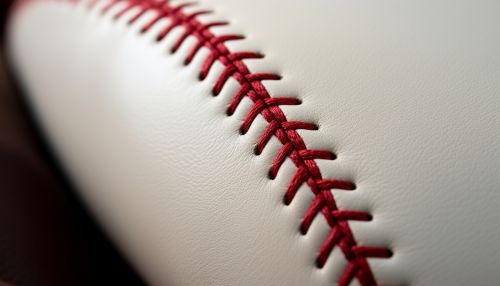Baseball (ball)
Introduction
Baseball is a type of ball used in the sport of the same name, played by millions of people around the world. The ball features a rubber or cork center, wrapped in yarn, and covered with leather. It is 9.00–9.25 inches (22.86–23.50 cm) in circumference, and 2.86–2.94 inches (7.26–7.47 cm) in diameter, with a mass of 5.00–5.25 ounces (141.75–148.83 grams).


History
The history of the baseball itself can be traced back to the mid-19th century, during the inception of baseball as a professional sport. The design and materials used in baseball construction have evolved over time, reflecting changes in the sport's rules and player preferences.
Design and Construction
Materials
The core of a baseball, also known as the "pill", consists of a small rubber or cork sphere, around which is wound layers of yarn or string. The pill is then coated in a layer of rubber adhesive before being wrapped in a final layer of yarn. The outer casing of the ball is made from two pieces of white leather, which are stitched together using 108 double stitches of red cotton thread.
Manufacturing Process
The manufacturing process of a baseball is a labor-intensive task that requires precision and skill. The pill is first formed by machine, but the winding of the yarn and the stitching of the leather is often done by hand. This process ensures that each ball meets the exact specifications required for professional play.
Specifications and Standards
The specifications for a standard baseball are set by the Major League Baseball (MLB) in the United States. According to these standards, a baseball must have a circumference of 9.00–9.25 inches (22.86–23.50 cm), a diameter of 2.86–2.94 inches (7.26–7.47 cm), and a mass of 5.00–5.25 ounces (141.75–148.83 grams). The ball must also bounce 54.5–57.5 inches (138.4–146.1 cm) when dropped from a height of 72 inches (183 cm) onto a concrete surface.
Variations
There are several variations of baseballs, designed for different levels of play and different environments. For example, a "safety ball" is used in youth baseball, which is softer and less dense than a standard baseball to reduce the risk of injury. In contrast, an "indoor baseball" is designed for indoor play, with a softer outer casing to prevent damage to walls and furniture.
Impact on the Game
The design and construction of a baseball can have a significant impact on the game of baseball. The weight and size of the ball can affect how far it travels when hit, the speed at which it can be pitched, and the ease with which it can be caught and thrown. Changes in the design or construction of the ball can therefore lead to significant changes in the nature of the game.
